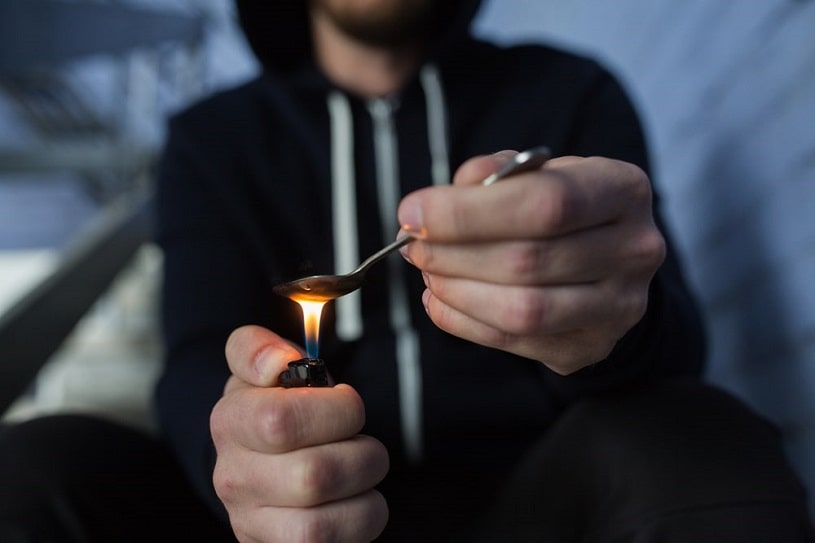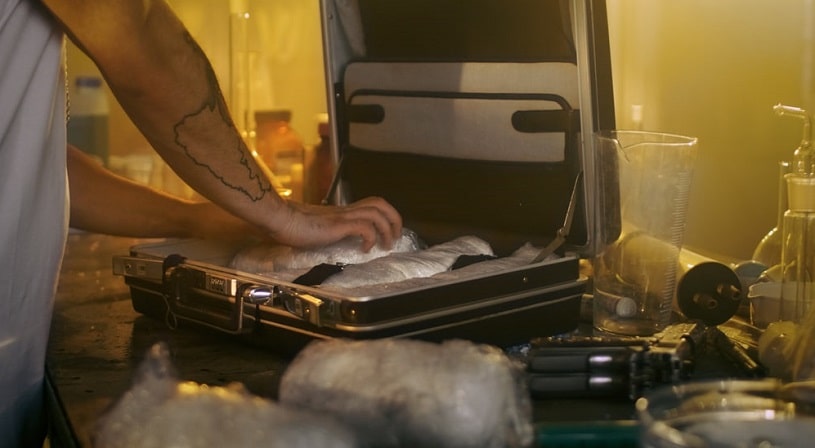Crack cocaine, also called rock cocaine, is a very dangerous drug, with users reporting intense cravings to use it and crack addiction after their first time taking it. Due to its extremely short half-life, users of rock cocaine are driven to binge on the drug, taking various doses, often increasing amounts, in a brief period. This method of using the substance multiplies the risks, making overdose likely. Quitting the drug causes crack withdrawal, which requires medical assistance and support.
Table Of Contents:
What Is Crack?
Crack cocaine is a stimulant drug that produces euphoric effects while speeding up mental processes and increasing energy. When smoked, as rock cocaine usually is, the high is felt almost immediately, but the effects the user is seeking tend to end within 10 minutes. These fuels rock cocaine binges, which in turn fuels a fast and powerful crack addiction.
Rock cocaine is a derivative of the substance cocaine, which has been cut during the process of making the drug. It comes in crystalline “rocks”, typically smoked through a pipe to achieve the desired effects. Due to it being a mix of cocaine and other substances, it tends to be both highly dangerous and addictive.
When powdered cocaine is mixed with water and other substances, like bicarbonate of sodium, it forms a solution that is boiled to form a solid. Upon cooling, it is broken into smaller pieces. It has a lower melting point than cocaine and makes a crackling sound when heated hence the name “crack”. Crack is smoked instead of snorted like powdered cocaine. The penalties for the possession of both substances are different.
How Addictive Is Crack?
Crack is highly addictive. In some cases, it can even cause addiction after the first use. Since it is smoked, it enters the lungs, where it comes into immediate contact with the blood and can reach the brain within seconds. On the contrary, snorted powdered cocaine takes minutes to reach the brain. The mode of consumption of a drug plays a key role in its addiction.
In the brain, crack increases dopamine release and reduces its reabsorption via dopamine transporters by blocking them. This high is short, around 10 minutes. After which, dopamine levels drop and create a low feeling, sometimes even depression. The dopamine levels take longer to go back to normal, making the person seek more substance to feel good.

More About Illicit Drugs:
Users often experience delusions with a feeling of bugs or insects crawling on their skin. This leads to scratches and bruises, which, combined with poor hygiene, can cause infections.
Crack is especially potent because the vapor inhaled is usually pure cocaine. When inhaled, pure cocaine is rapidly assimilated into the blood through the lungs, traveling to the brain in less than a minute. The resulting high is near-instantaneous and extremely intense.
Despite the dangers of the drug, many users will still struggle to quit because of their addiction.
Crack addiction is caused by a variety of factors. One of the main factors is the psychological euphoria it creates within users. This makes them want to come back, time and time again, looking for the same high. The drug is also physically moreish. When a user stops taking the drug, they will experience crack withdrawal symptoms. These symptoms, especially the cravings, will become so unbearable during the withdrawal that the user will seek out more of the drug and continue use. This triggers a continuous downward spiral until the drug rules their life.
Crack Cocaine History
Rock cocaine is just one interesting section in the history of cocaine. But when was it created, and who invented crack? The substance came into being during the cocaine boom in the 1970s. It then took the best part of the next decade to hit the heights of its popularity during the 1980s.
Crack cocaine was developed from coca leaves, just like cocaine itself. However, the drug was then crystallized and cut several times during the production process. It was initially produced by South American drug cartels for two reasons. The first reason was to get around newly developed laws created by the US government to monitor cocaine consumption and lessen it where possible. The second was due to the incredible amounts of cocaine entering the US, and prices had dropped by around 80%. Producing the substance meant that it could get around laws by adding extra ingredients, as well as selling the product in smaller doses so that it was far more profitable.

By that point, crack in America was incredibly popular, so the purity of the cocaine wasn’t a worry to anyone consuming it. However, there was very little awareness of what they were consuming. This included the lack of knowledge of the symptoms of smoking crack, as well as the issues it could cause in the future, such as crack baby syndrome.
The 1980’s Crack Epidemic
During the 1980s in the United States, the nation was struck by a sudden crack epidemic. The crack epidemic of the 1980s was caused by some different factors integrating to create its incredible rise in popularity.
One of the factors that caused the sudden crack epidemic in the United States was the government. This is because the government placed restrictions on the ingredients in cocaine, which led to rock cocaine being created to bypass these regulations. Some people even consider the government to be the inventors of crack cocaine. However, this is almost certainly not true, as the substance was a creation of South American cartels looking to improve their income.
Another reason crack came into being was the price of cocaine. Due to their being so much of the substance around at the time, prices had hit the floor. Dealers and cartels were struggling to turn a profit. Therefore they created crack to use less of the drug in each batch when mixing it with other substances.
Crack epidemic statistics suggest that the results of the drug influx were substantial. By 1987 it had conquered all but 4 states in the US. It then gradually made its way across the world. By 2002, countries in Europe, such as the United Kingdom and The Netherlands, struggled to deal with the large quantities of the drug suddenly entering their borders. During the United States epidemic, the number of people who admitted to using any kind of cocaine increased by an astonishing 1.6 million, from 4.2 to 5.8 million.
There was also a large negative fallout from the epidemic. Cocaine hospital incidents in 1985 rose by 12% to 26,300 people. They continued to rise a year later, to 55,200 people. The casualties and ailments from crack were largely in the less well-off communities of big cities. These communities had previously not had access to the rich life of cocaine, and suddenly they could afford the substance due to crack. Gangs also began to develop, initiating regional wars over the drug. These territorial battles created more fall out, with the rise of gun crime, gang attacks, and assaults increasing in quantity.
The Symptoms and Signs of Crack Use
A user will usually display symptoms of crack use, no matter how long they have been using the drug. The stimulant has clear, dangerous signs that make stimulants stand out from many other kinds of substances. These signs of crack use can be used to identify someone abusing the drug to ensure they get the help they need.
Psychological Signs of Crack Abuse
Psychological signs of someone on crack are clear and substantial. A person’s psyche under the influence of the substance changes drastically following an addiction. To better recognize abuse, one has to understand the way rock cocaine influences the mind. Its addictive high and extreme euphoria make the world around the user seem surreal and intense, albeit for a very short duration of time. The person’s brain under the influence of cocaine rapidly fires dopamine, which regulates our mood, including excitement and pleasure.
In Short, General Effects Of Crack Use Include:
- A sense of self-importance and invincibility
- Strong euphoria
- Bursts of energy
- Sharp focus
- Detachment from reality
The tell-tale signs of use will commonly include sudden and unexpected bursts of energy, surpassing any reasonable amount of excitement. This state of mind and the heavy crashes that accompany it are the first indicators of developing a dependency. This addiction comes with a disorientating, confusing, and paranoid mindset, which further exacerbates the problem. At this stage, users are likely to feel depressed, irritated, and solely focused on their next high.
As soon as they smoke the next dose, certain psychological signs of intoxication will help identify a crack cocaine abuse problem. These Include:
- Aggression
- Mood swings
- Inability to stop the habit
- Hallucinations
- Paranoia
- Irritability
- Depression
Physical Symptoms of Crack Consumption
Body chemistry sharply changes in people who smoke rock cocaine, too. Because cocaine acts as a central nervous (CNS) stimulant, targeting our dopamine receptors primarily, changes will be most evident in those regions of the body where movement, appetite, and stress are regulated. For example, a person under the influence of cocaine may be talking rapidly, sweat profusely, shake all over, or have a fast heart rate.
Physical Signs Of Crack Use Are:
- Insomnia
- Increased blood pressure and heart rate
- Dilated pupils and bloodshot eyes
- Changes in appetite
- Jitters
The list of adverse side effects doesn’t end there, though. Much of it will depend on the method of administration, too; smoking the rocks causes numbness and a burning sensation, while shooting the drug up can lead to collapsed veins and injection marks. Users believe snorting the drug will quicken the onset of effects, but the results are quite the contrary. Not only does frequent snorting lead to nasal damage and a sore, runny nose, it also reduces the bioavailability of the drug. In other words, the chemicals only get partially absorbed as it ends up in the stomach.
Behavioral Changes of the Addict
Crack addiction behavior creates an incredibly debilitating situation for both the user and his or her loved ones. Work attendance, school obligations, and general responsibilities all lose priority as the drug becomes the user’s obsession. It’s all they care about. This can make the user appear selfish and inconsiderate of the damage he or she is doing to the family along the way, but it is important to understand the nature of addiction.
Consistent crack abuse is a tough habit to overcome. Not least because the person may deny their wrongdoing and hide behind accusations and well-thought excuses, they may be manic, paranoid, and difficult to speak with because of their aggressive or agitated standpoint.
An Addict Will Often Display:
- Unsafe sexual tendencies. Addicts under the influence commonly have an intensified sexual urge and engage in unprotected intercourse, sometimes with multiple partners, which can lead to a range of problems
- Violent behavior. This is one of cocaine's hallmarks. A person high on the drug is more likely to abuse those close to them because of their aggressive and intense stance
- Negligence of dangers. When it comes to obtaining their next dose, addicts know of no limits or precautions. They will often enter dangerous neighborhoods and get themselves into hazardous situations only to make their next purchase
- Carelessness. This extends far beyond work or school obligations. An addict will also disregard their monthly bills, relationships, or even their own family
- Law-breaking behavior. One may probably be aware that many crack addicts steal to fund their habit. They may also engage in prostitution and a range of criminal activities to support their addiction financially
Finally, seeking out the substance is a behavioral sign of addiction on its own. Even when the world around them is crumbling, an addict won’t discontinue his use. This inability to think logically and objectively is why it is so difficult to persuade the user to seek help. However, if they persist in their behavior, no good will come out of it. Effects of crack abuse and long-term exposure to the drug can severely damage the liver, heart, and kidneys. Developments of these diseases often lead to coma and even death.
How Long Does Crack Stay In Your System?
Crack half-life is relatively short, which means it will not be detectable for long in most cases. When it comes to understanding how long rock cocaine remains in the system, first, the individual needs to understand metabolism in general. Ultimately, no online guide can tell a person exactly how long the substance will remain in their system after use because everyone’s metabolism is different. Some factors that can impact the metabolism of the drug include age, diet, intestinal flora, sex differences, enterohepatic circulation, general individual variations, the dose taken, the frequency of use, and the method of administration. For example, a young, healthy person who used once will eliminate the drug faster than someone who is older, unhealthy, and uses it often.

Another consideration when it comes to testing is which test is run. Different tests will detect the presence of the drug, its metabolites, and anhydroecgonine methyl ester (the key indications of the presence of crack cocaine) for longer than others. As such, users should think about the metabolism of crack in a general manner, understanding it may vary between individuals, and focus on the method of testing that is of most concern to them.
How Long Does Crack Stay in The Urine?
According to a study, cocaine in any form will metabolize quickly and flood the system within minutes of use, making it detectable in a test almost immediately. The method of administration impacts the levels of the drug detected in the urine. Intravenous use caused the highest concentration, followed by intranasal use, and finally, smoking. In most users, the levels of cocaine, its metabolites, and anhydroecgonine methyl ester will be below the detection limit within 24 hours.
How Long Does Crack Stay in The Blood?
Compared to urine-based tests, blood tests for crack will detect the drug’s presence for longer. While the average person will be below the level of detection in the urine just 24 hours after use, blood tests will still reveal crack cocaine use roughly 48 hours after use.
How Long Does Crack Stay in The Saliva?
Drug testing using saliva has increased in popularity in recent years because it is easy to collect, nearly impossible for the user to trick, and the tests are cheap to run. However, these tests have a lot of problems. For example, the user may not naturally produce enough saliva to collect a testable sample. At the same time, foods can be used to stimulate production, which may then alter the test results. The reliability of the tests also varies based on the method of collection. Ultimately, it does not detect the presence of crack cocaine any better than urine tests, with presence dipping below the detectable limit within 24 hours in most users.
How Long Does Crack Stay in The Hair?
As the drug will enter the hair at the cuticle when the body metabolizes it, since hair is dead, the drug remains in the portion where it entered. By analyzing strands of hair, laboratory technicians can determine if the person used a drug and how frequently they used it and if they went through periods of avoiding drug use. This evidence is within the hair itself and cannot be washed away.
So, how long will hair reveal crack cocaine use? It will do so until the portion of hair containing the evidence is cut off or the strand of hair naturally falls out. This means that it will remain in the hair for several months to several years after use.

Crack Appearance On Drug Testing
While many people being tested for drug use are worried about how to pass a drug test after smoking crack, many people walk into their tests assuming that all will be well, either because it has theoretically been long enough since they used that the test should be negative, or because they honestly have not used it at all. However, crack drug tests, and other drug tests can read positive when there does not seem to be a reason for this to happen.
The tests that most often result in false positives are at-home tests, often used by parents on their children to ensure that they do not abuse drugs. These are crack urine tests, and the results can be impacted by taking the test incorrectly, improper storage of the test or urine, food, or drink consumed before the test, and prescription medications.

However, there are occasions where laboratory results also come back with a false positive. After a surgery where cocaine was used as an anesthetic, a test for benzoylecgonine might come back as positive. Coca leaves have cocaine in them, and herbal teas made from them can give a positive test. Additionally, the second-hand crack smoke drug test may come up positive even though the person did not actively consume the drug.
Crack Withdrawal
Crack is a heavily cut form of cocaine mixed with various other ingredients such as baking soda or even rat poison. Because it takes effect so fast and stimulates the user, the drug makes them go back for more, leading to tolerance and withdrawal symptoms when they try to quit.
Despite the same active chemical, when cocaine is snorted in powder form, it is absorbed by the mucous membranes and takes time to reach the brain, and because of its high melting point, it cannot be used for smoking easily. On the other hand, crack has a low melting point and is usually smoked. It reduces the time it takes for the drug to reach the brain from minutes to seconds. Once in the brain, it acts on the communication pathways and increases dopamine release, a neurotransmitter that gives a good feeling to the user. It also attaches itself to the dopamine transporter to stop the reabsorption of excess dopamine into the cell. The user feels alert and happy. However, this high is short-lived, and the amount of dopamine drops within minutes and makes the user feel down, even depressed. Since the drug meddles with the natural levels of dopamine, it takes the body a while to get back to normal on its own. This makes the users seek this instant high repeatedly to avoid the gloomy feeling followed by the high (which can appear more difficult in contrast), leading to addiction. It is even possible for users to get addicted to crack after just one use.
Crack Cocaine Withdrawal Symptoms
The exact manner in which crack withdrawal syndrome presents will vary from person to person, usually determined by how heavy their use was and how their bodies and minds responded to the drug. For example, those who use multiple times a day in high doses and are prone to addiction will struggle the most in getting through the withdrawal process. Those who only use on occasion but feel cravings for the drug will usually have the easiest time getting through the withdrawal phase. It can also depend on how the drug was consumed.
Crack withdrawal symptoms are not pleasant. In some cases, they can be deadly, which is why the process should be done in a supervised rehabilitation center. While these symptoms can sound intimidating, the user needs to understand that they are part of the path to a healthier life, and with medical assistance, they will be manageable.
Physical Symptoms
- Slowing of activity
- Fatigue
- The general feeling of discomfort
- Increased appetite
- Aches and pains
- Exhaustion
- Shaking
- Sweating
- Vomiting
Mental Symptoms
- Anxiety
- Vivid and unpleasant dreams
- Depressed mood
- Suicidal thoughts
- Extreme cravings
- Agitation and restless behavior
- Difficulty concentrating
- Difficulty sleeping
- Lack of motivation
- Inability to feel pleasure
- Anger or emotional outbursts
- Insomnia
- Paranoia
Additionally, due to the extreme cravings, the user is at greater risk of overdose during this time. This is because the cravings are so intense, the user will be tempted to take larger doses, and depending upon how long they have been in the withdrawal process, their body may be less able to metabolize the drug than it was when they last used. Crack paranoia and seizures are also common during the process.
Duration of Detoxification
How long the withdrawal lasts varies from user to user. A person’s tolerance to the drug, other individual characteristics, duration, and frequency of abuse all contribute to the severity of the withdrawal symptoms and how long they last. The first symptoms of withdrawal can start after 30 minutes to 72 hours of the last use. These are severe and called acute withdrawal symptoms. This initial phase is followed by post-acute withdrawal symptoms or PAWS. The withdrawal symptoms can be observed for several weeks to months after the last use.
The user must understand that withdrawal duration is not the same as the duration of rehabilitation treatment; rehabilitation will continue after the withdrawal process is complete, and recovery will last a lifetime.
Scientific research divides crack withdrawal syndrome into three distinct stages. These are called crash, withdrawal, and extinction. The user can expect to experience the steps in this order.
A crash occurs directly after the cessation of the use of cocaine in any form. Because cocaine does not stay in the system for long, the crash occurs quickly after the last use of the drug. It is characterized by dysphoria, irritability, anxiety, desire for sleep, and increased appetite. At this point, the user generally will feel less desire to use. The crash stage is something rock cocaine users deal with frequently, often after every use or binge on the drug.
Withdrawal is phase two. During this stage of the process, the user will feel intense cravings for the drug. They also tend to have trouble concentrating on tasks and exhibit irritability, ranging from mild to severe and tend to be lethargic. Users may experience this stage even when not trying to detox simply because they go long enough between doses for withdrawal to kick in. Detoxing from crack can take several weeks or several months, depending on the doses and frequency of use.

The final phase of the withdrawal process is extinction. The extinction phase can be thought of as the phase where the addiction dies. This is where the user stabilizes physically and mentally, and their desire for the drug becomes nearly non-existent. Cravings will occur sporadically, especially at the start of this phase. The extinction phase is when the rehabilitation process really kicks into gear, and the phase may last as long as 28 weeks.
While users may wonder how to get crack out of their system fast, it is important to note that doing so does not mean skipping the withdrawal phases. In fact, it will only cause their onset to occur sooner.
Crack Addiction Treatment and Detox
Crack addiction help is easy to come by as there are numerous rehabilitation centers located across the United States, offering detoxification and rehabilitation of addicts. These centers offer various therapies and approaches to entering recovery, and they come in a wide range of prices.
In the steps to overcoming addiction, the first step is seeking treatment. For many users, this is hard to do because they have to admit that they have a problem, and crack side effects are not enough to convince them. Those suffering from crack addiction will often find ways to rationalize, justify, or downplay their drug abuse.
Another common problem is the stigma attached to drug use by society. Due to this stigma, some rock cocaine users realize they need help but hesitate to seek it because they are ashamed of their vice. They might even believe they are not worthy of being helped.
No matter what obstacles stand in front of the user, they must seek crack addiction treatment.
The risks of continued use are just too high, with studies finding that rock cocaine addicts are at high risk of death from overdose, disease, and even homicide. Everyone deserves the chance to live a long and healthy life.
There are some treatment options available to help a user through recovery for crack abuse. The most commonly used treatments are inpatient treatment centers and outpatient treatment. They are often used alongside other forms of recovery help, such as therapy and counseling. So quitting is necessary to lessen crack effects.
Treatment Options Include:
- Inpatient Treatment
- Outpatient Treatment
- Counseling
- Group Therapy
- Psychotherapy
- Natural Remedies, which are alternatives to drugs. They may help with cravings or help to create a better mindset for the user. Natural remedies include yoga, protein, and omega 3
For the most successful treatment, one should consult with a medical professional to find the most suitable option. Furthermore, when it comes to successful treatment, it is vital to have the right support. Withdrawal will be difficult, so for successful treatment, a user’s mind must be focused on recovery.
Crack Detox Treatment
Treatment and detox from crack cocaine in a rehabilitation center tends to follow certain guidelines applied to detoxing from most stimulant drugs. This includes careful monitoring of the patient, medications that help the user get through the process, and following a specific regimen of vitamins, exercise, water intake, and diet. Patients who exhibit severe depression and anxiety or even develop psychosis will be given specialized treatment. Once the patient is mentally stable, they will begin the therapy portions of rehabilitation, developing the skills needed to say no to drugs for the rest of their lives.
In general, the detoxification process begins with the user living at the rehabilitation facility, allowing for complete monitoring of the process and eliminating patient access to crack. Once the intense cravings are gone, and the patient is in the extinction phase, outpatient care may be used if that is what the patient wants. However, some patients feel better remaining in the rehabilitation facility’s controlled environment until they are ready to enter the recovery stage.
Detoxification is the first step in recovery from a crack addiction. While detoxification itself can be dangerous when done alone by quitting cold turkey, the risks are low in a supervised setting with medical guidance. Additionally, any risks associated with rock cocaine detoxification are ultimately less than those of continued use, which can cause delirium or psychosis, heart attack and heart disease, stroke, respiratory failure, brain seizures, and even death.
Staying Clean
There are many reasons to quit crack. Firstly, it is an incredibly addictive and dangerous drug. In addition to that, it can also be harmful to decision making and relationships. As these reasons highlight, the drug is harmful to more than just the user in the long term. When it comes to quitting rock cocaine, one has to be up for a substantial challenge. It is not recommended to try to quit the highly addictive substance without medical support. Anyone using the drug should seek crack addiction recovery.
With the right approach, rehabilitation, and recovery can be successful. Through this, the user will be able to avoid overdose and improve their life.
Frequently Asked Questions
What does crack look like?
Crack cocaine looks like crystals or rocks hence the common name “rocks”. It ranges from clear to opaque in appearance with a white, off-white, or yellow color depending on the impurities that are present. Different substances are added to cut the weight or modify the drug’s properties, which change the color of the drug.
What does crack smell like?
The smell of smoking crack cocaine is often described as burning plastic or burning rubber by users. Different impurities that are added during preparation can vastly alter the aromatic profile of the drug. Crack is a mixture of chemicals, and the combined smell is somewhat similar to that present in the air of a nail salon.
Page Sources
- Haas C, Karila L, Lowenstein W., Cocaine and crack addiction: a growing public health problem, https://www.ncbi.nlm.nih.gov/pubmed/20120283
- André de Queiroz Constantino Miguel, Contingency Management Treatment for Crack Addiction – Study With Brazilian Population, https://clinicaltrials.gov/ct2/show/NCT01815645
- Melody Redman, Cocaine: What is the Crack? A Brief History of the Use of Cocaine as an Anesthetic, https://www.ncbi.nlm.nih.gov/pmc/articles/PMC4335732/
- U.S. Department of Justice Drug Enforcement Administration, The Cocaine Threat to the United States, https://www.ncjrs.gov/pdffiles1/Digitization/154678NCJRS.pdf
- National Drug Intelligence Center. Crack Cocaine Fast Facts. https://www.justice.gov/archive/ndic/pubs3/3978/3978p.pdf
- Department of Health.The cocaine withdrawal syndrome. 2004. https://www1.health.gov.au/internet/publications/publishing.nsf/Content/drugtreat-pubs-modpsy-toc~drugtreat-pubs-modpsy-3~drugtreat-pubs-modpsy-3-7~drugtreat-pubs-modpsy-3-7-cws
- Dolan K. Clinical Guidelines for Withdrawal Management and Treatment of Drug Dependence in Closed Settings. 2009;105(7). https://www.ncbi.nlm.nih.gov/books/NBK310652/
- Duke University. Content Background: Why is smoked cocaine (crack) more likely to be abused or addictive than snorted cocaine? https://sites.duke.edu/thepepproject/module-1-acids-bases-and-cocaine-addicts/content-background-why-is-smoked-cocaine-crack-more-likely-to-be-abused-or-addictive-than-snorted-cocaine/
- Dasgupta A. Biotin and Other Interferences in Immunoassays: A Concise Guide. Elsevier; 2019. https://www.sciencedirect.com/science/article/pii/B9780128164297000071
- Estroff, Todd Wilk. Manual of Adolescent Substance Abuse Treatment. 2008. Washington, D.C.: American Psychiatric Publishing. pp. 44–45. https://books.google.it/books?id=GLcdUyQsxbgC&printsec=frontcover&hl=it
- Somchai Rice. Investigating the aroma of marijuana, cocaine, and heroin for forensic applications using simultaneous multidimensional gas chromatography - mass spectrometry - olfactometry 2015. https://lib.dr.iastate.edu/cgi/viewcontent.cgi?article=5645&context=etd
- URMC. Understanding Cocaine and Crack. 2020. https://www.urmc.rochester.edu/encyclopedia/content.aspx?contenttypeid=1&contentid=2600
- NYC Health. Cocaine Abuse & Addiction https://www1.nyc.gov/site/doh/health/health-topics/cocaine-abuse-and-addiction.page
- Deonna S. Turner. Crack Epidemic. https://www.britannica.com/topic/crack-epidemic
- NIDA. What are some signs and symptoms of someone with a drug use problem? https://teens.drugabuse.gov/content/what-are-some-signs-and-symptoms-someone-drug-use-problem
- Plano. Crack & Cocaine. https://www.plano.gov/DocumentCenter/View/127/Drug-Info---Crack-Cocaine-FM-601251?bidId=

 Authored by
Authored by  Reviewed by
Reviewed by 


